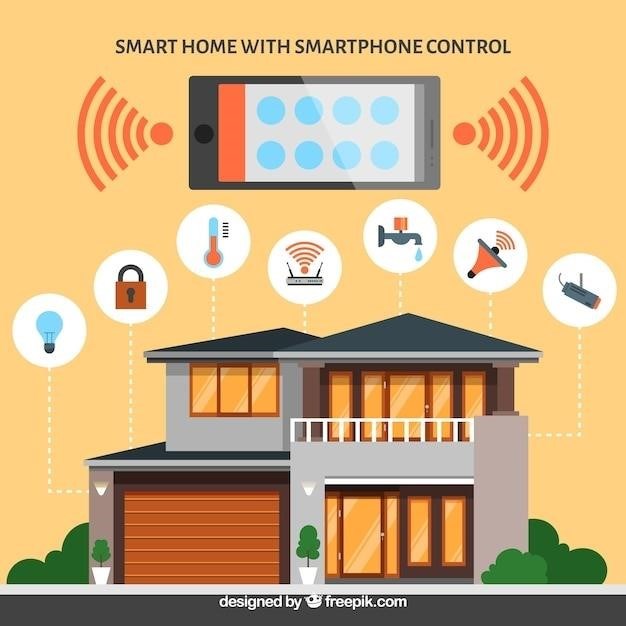VTech DECT 6.0 Manual⁚ A Comprehensive Guide
This manual provides complete instructions for setting up and using your new VTech DECT 6.0 phone. It covers installation, operation, troubleshooting, and advanced features. Ensure proper functionality by reviewing this guide thoroughly.
Introduction and Initial Setup
Congratulations on your purchase of the VTech DECT 6.0 phone! This section guides you through the initial setup process, ensuring a smooth and efficient start. Before you begin, please carefully unpack your phone system and check for all included components⁚ the base unit, handset(s), power adapter, telephone line cord, and any additional accessories mentioned in your specific model’s packaging. Familiarize yourself with the layout of the base unit and handset, noting the placement of buttons, ports, and displays. The base unit will typically have a power port for the adapter, a port for connecting your telephone line, and potentially other ports depending on your model’s features. The handset will likely have buttons for basic phone functions, a display screen for call information, and possibly additional buttons for accessing advanced features like the answering machine.
Ensure the base unit is placed in a central location within your home, away from electronic interference and in a position that provides optimal signal strength for the handset. Avoid placing the base unit near metal objects or other electronic devices that might disrupt the signal. Before connecting the telephone line cord, make sure it is securely plugged into both the wall jack and the designated port on the base unit. Once the line cord is connected, plug the power adapter into the base unit and then into a standard electrical outlet. Allow the base unit to power on and fully initialize before proceeding to connect the handset(s) and configure the device settings. Refer to the next section for instructions on connecting your handset(s) to the base unit.
Connecting the Base Unit and Handset
Connecting your handset(s) to the VTech DECT 6.0 base unit is a straightforward process. First, ensure that the base unit is powered on and has completed its initial startup sequence. You should see some form of visual indication (lights or display) confirming that the base unit is ready for handset registration. Most VTech DECT 6.0 models utilize a registration process to pair the handset(s) with the base unit. Consult your model’s specific instructions for the exact procedure, as it may vary slightly. Typically, this involves pressing and holding a specific button on the base unit, often labeled “Register” or a similar designation. The base unit will then enter a registration mode, indicated by a flashing light or a message on its display.
Next, turn on your handset. Many models will automatically begin searching for the base unit once powered on, while others might require you to initiate the registration process manually on the handset itself. This often involves pressing and holding a button labeled “Register,” “Link,” or a similar command. The handset will then search for available base units within range. Once the base unit and handset(s) have successfully connected, you will typically receive a confirmation indication on both devices. This may take the form of a solid light, a confirmation message on the display, or a combination of both. If you are experiencing difficulties, double-check that the handset is within a reasonable range of the base unit and that there are no obstructions interfering with the wireless signal. Refer to the troubleshooting section if you encounter persistent connection problems. After successful pairing, you can proceed to install batteries (if necessary) and configure the phone’s settings.
Installing Batteries and Charging
Your VTech DECT 6.0 handset likely requires rechargeable batteries for operation. Before installing batteries, carefully read the instructions provided with your specific model. Most handsets utilize standard rechargeable NiMH (Nickel-Metal Hydride) batteries. Ensure you use the correct type and size of batteries recommended by VTech to avoid damage to your phone. Incorrect battery installation can lead to malfunction or even damage to the handset. Typically, the battery compartment is located on the back or bottom of the handset. Open the compartment following the instructions in your manual; this may involve sliding a cover, pressing a latch, or using a small tool. Once the compartment is open, carefully insert the batteries, paying close attention to the polarity indicators (+ and -) marked inside the compartment. Incorrect polarity can damage the batteries and your phone. Most models have clear markings indicating the correct placement of the positive (+) and negative (-) terminals. After inserting the batteries, securely close the battery compartment.
After installing the batteries, place the handset on the charging base. The base unit typically has a cradle or charging contacts designed to charge the handset’s batteries. Ensure the handset is properly seated in the cradle or charging contacts to ensure proper charging. Many models will indicate that the handset is charging via a light on the base unit or a visual indication on the handset’s display. The charging time will vary depending on the battery’s capacity and charge level. Refer to your user manual for the estimated charging time for your specific model. Once fully charged, your handset will be ready for use. Avoid leaving the handset on the charging base continuously for extended periods, as overcharging can reduce the lifespan of the batteries. Always refer to VTech’s recommendations for optimal battery care and charging practices.
Setting the Date and Time
Setting the correct date and time on your VTech DECT 6.0 phone is crucial for features like Caller ID and the answering system’s timestamping. The process varies slightly depending on your specific model, so consult your user manual for precise instructions. Generally, you’ll navigate to a “Settings” or “Setup” menu via the handset’s buttons. This often involves pressing and holding a specific button, or a sequence of button presses, until a menu appears on the LCD screen. Look for options related to “Date,” “Time,” “Clock,” or similar terms. The menu navigation might involve using directional buttons (up, down, left, right) or a combination of buttons to select options and input values.
To set the date, you’ll typically be prompted to enter the month, day, and year. The phone might use a numerical format (e.g., MM/DD/YYYY or DD/MM/YYYY) or a menu system where you select each element individually. For the time, you’ll enter the hours and minutes, and possibly seconds, specifying AM or PM if necessary. Some models automatically detect the time zone based on your location, while others might require you to manually select the correct time zone from a list. After making your selections, confirm your entries to save the changes. The phone’s display should now reflect the newly set date and time. Remember, if the date and time are not set correctly, features that rely on accurate timestamps, such as Caller ID with date and time information, may not function properly. If you experience difficulties, refer to the troubleshooting section of your manual or contact VTech customer support for assistance.
Understanding the Display and Menu Navigation
Your VTech DECT 6.0 phone’s display is your window into its various functions. The LCD screen typically shows the current time, date, signal strength, and often the status of features like call waiting or the answering machine. Understanding the icons and information displayed is crucial for efficient use. Many models display a series of indicators, such as a battery level icon, a signal strength indicator (bars indicating the connection to the base unit), and an icon that shows the current mode (e.g., idle, call in progress, answering machine active). These icons provide at-a-glance status updates. The specific icons and their meanings are detailed in your phone’s user manual.
Navigating the phone’s menus is generally intuitive but depends on your model. Most VTech DECT 6.0 phones utilize a combination of buttons to access and navigate through different settings and features. The “Menu” button is typically the primary way to enter the main menu. From there, you’ll use directional buttons (usually up, down, left, right) to scroll through options and select them. A “Select” or “OK” button confirms your choices. Some models might have dedicated buttons for specific functions, such as accessing the answering machine or Caller ID. The user manual should provide a detailed explanation of all buttons and their functions, including shortcuts and specific key combinations for quick access to common settings. Familiarizing yourself with these controls is essential for efficient operation of your VTech DECT 6.0 phone.
Making and Receiving Calls
Making calls on your VTech DECT 6.0 phone is straightforward; Simply lift the handset to activate it. You’ll see the dial pad on the display. Enter the phone number using the numeric keypad, pressing the “Send” or equivalent button to initiate the call. During a call, you can adjust the volume using the volume control buttons located on the handset. Most models have visual indicators to show the call status, such as an “in-call” display or a busy signal icon.
Receiving calls is equally simple. When a call comes in, the phone will ring, and the caller ID (if enabled) will be displayed on the screen, showing the number and potentially the name of the caller. Answering an incoming call is usually done by pressing the “Answer” button on the handset. To end a call, press the “End” or “Hang Up” button. If you have multiple handsets registered to the base station, calls can ring on all of them simultaneously. This feature offers convenience, allowing you to answer a call from any handset within range; Your VTech DECT 6.0 phone may also offer call waiting functionality. If you receive a second call while already on a call, you will be alerted. Consult your user manual for specific instructions on managing call waiting and placing calls on hold.
Using the Answering System
Your VTech DECT 6.0 phone likely includes a built-in answering machine. To activate it, locate the answering machine controls on the base unit. These usually consist of buttons for playback, recording, and message management. Many models allow you to customize settings such as recording time (often up to 22 minutes), and whether to announce your name before recording messages. The announcement can be pre-recorded or customized using the phone’s menu system. Consult your user manual for precise instructions on the specific model you own.
To check for new messages, press the playback button. The answering machine will replay any stored messages. Navigation controls usually allow you to fast-forward, rewind, and delete messages individually or in bulk. Some models feature remote access, allowing you to check your messages remotely using another phone. This is typically done by dialing your own phone number and following the prompts. Remember to regularly check and delete old messages to free up space on your answering machine. The capacity varies depending on the model, so refer to your user manual for details on message storage. Most models also have visual indicators to alert you to the presence of new messages on the base unit’s display.
Accessing Advanced Features (Caller ID, Call Blocking etc.)
Many VTech DECT 6.0 phones offer advanced features beyond basic calling. Caller ID, a standard feature on most models, displays the phone number and sometimes the name of the incoming caller on the handset’s screen. This allows you to screen calls before answering. To activate Caller ID, ensure it’s enabled in your phone’s settings menu. The specific menu path varies depending on the phone model; consult your user manual for detailed instructions.
Call blocking is another valuable feature. This allows you to block unwanted calls from specific numbers or types of numbers, such as unknown or private numbers. The method of blocking calls varies by model, but typically involves adding numbers to a “blocked” list within the phone’s settings. Some models might also offer call waiting, allowing you to put one call on hold while answering another. This is usually activated through a dedicated button on the handset. Explore your phone’s menu system to discover other advanced features such as call forwarding, which redirects calls to another number, or intercom functionality for internal communication between handsets if your model supports multiple handsets.
Remember that the availability and specific operation of these features depend entirely on your VTech DECT 6.0 phone model. Always refer to your model’s specific user manual for detailed instructions and configuration options.
Troubleshooting Common Issues
Experiencing problems with your VTech DECT 6.0 phone? This section addresses common issues. If you’re having trouble making or receiving calls, first check the phone line connection at both the wall jack and the base unit. Ensure the line cord is securely plugged into both ends. A loose connection is a frequent culprit. Next, verify the power supply to the base unit. Make sure the power adapter is correctly plugged into the base and a functioning wall outlet. If using rechargeable batteries in the handset, ensure they are properly installed and adequately charged.
Poor audio quality can stem from several factors. Check the handset’s volume level. If the volume is too low, adjust it accordingly. Excessive background noise might indicate interference. Try moving the phone to a different location, away from potential sources of interference like electronic devices or power lines. If you’re experiencing static or crackling sounds, the problem may lie with the phone line itself. Contact your telephone service provider to investigate the issue.
If the handset displays an “out of range” message, the handset is too far from the base unit or there is interference obstructing the signal. Try moving the handset closer to the base or relocating the base to a more central position. If the problem persists despite these steps, consult your user manual for advanced troubleshooting options or contact VTech customer support for assistance.
Addressing “Out of Range” Problems

The “out of range” message on your VTech DECT 6.0 phone indicates the handset is too far from the base unit or encountering signal interference. Before attempting more complex solutions, ensure the base unit is positioned centrally within your home for optimal signal coverage. Avoid placing the base unit in locations with metal obstructions, such as large metal appliances or cabinets, as these can significantly weaken the signal. Similarly, keep the base away from sources of electronic interference, like microwaves or Wi-Fi routers, which can disrupt the DECT signal.
Check for any obstructions between the handset and the base unit. Thick walls, especially those containing metal reinforcements, can attenuate the signal. If possible, relocate the base unit or handset to a location with fewer obstructions. Consider also the distance between the base and handset. The range of a DECT 6.0 phone is typically limited, and exceeding the manufacturer’s specified range will likely result in connection problems. If the problem persists despite these adjustments, examine the base unit’s antenna. Ensure the antenna is fully extended and not damaged in any way.
In some cases, interference from other cordless phones or electronic devices can disrupt the signal. Try temporarily turning off other cordless phones in the vicinity to see if this resolves the issue. If the problem continues after these troubleshooting steps, check the batteries in your handset. Weak batteries can sometimes impact the signal strength. Replacing them with fresh batteries may improve the range. If problems persist, consult the user manual or contact VTech support.

Resolving Power Issues at the Base
If your VTech DECT 6.0 base unit is experiencing power problems, the first step is to check the power cord. Ensure it’s securely plugged into both the base unit and the wall outlet; A loose connection is a common cause of power issues. Try a different wall outlet to eliminate the possibility of a faulty outlet. If the problem persists, inspect the power cord for any visible damage, such as fraying, cuts, or kinks. A damaged power cord needs to be replaced immediately; using a damaged cord presents a safety hazard. Do not attempt to repair a damaged cord yourself.
Examine the power adapter. The adapter converts the wall voltage to the voltage required by the base unit. A malfunctioning adapter can prevent the base unit from receiving power. Try using a different power adapter if you have a compatible one. If the power adapter seems to be the culprit, contact VTech support or a qualified repair technician for a replacement. Check the power switch on the base unit itself. Sometimes a simple power cycle can resolve temporary power issues. Turn off the base unit, wait a few minutes, and then turn it back on.
After checking these basic components, consider the possibility of a more serious internal problem. If none of the previous steps resolve the power issue, the problem might be internal and require professional attention. Contact VTech customer support to determine if your phone is still under warranty or inquire about repair options. Attempting to repair the base unit yourself is strongly discouraged, as this could void the warranty and potentially cause further damage.



